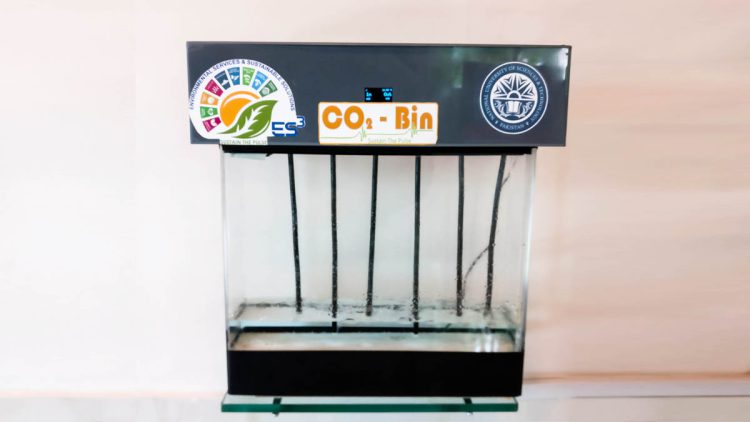Pakistan, one of the world’s most vulnerable countries to climate change, is tackling the escalating challenges posed by greenhouse gas emissions and climate-related disasters. Despite its relatively low contribution to global emissions, the nation experiences a wide range of climate change impacts due to its diverse geography. In 2022 alone, Pakistan faced a series of devastating climate events, including wildfires, heatwaves, glacial outburst floods (GLOFs), glacier melting, and a catastrophic mega flood caused by hill torrents. These events served as a wake-up call for the world, highlighting the urgency of addressing climate change.
In response to these challenges, Prof. Dr. Muhammad Fahim Khokhar and his team from the School of Civil and Environmental Engineering (SCEE), National University of Sciences and Technology, Islamabad have developed innovative and cost-effective solutions to enhance Pakistan’s resilience to address the adverse effects of climate change by mitigating CO2 emissions.
The groundbreaking technology – developed in a bid to combat this critical issue by sequestering CO2 emissions – involves two indigenous products: CO2-Bin and CO2-Arrestor, aimed at reducing greenhouse gas emissions from the building and transport sectors, respectively. The CO2 Bin is designed to sequester (isolate) carbon dioxide from indoor environments, such as buildings (currently, contributing to 27% of Global GHG Emissions). It not only improves indoor air quality but also raises awareness about air pollution and climate change among citizens, promoting sustainable lifestyles and reducing overall GHG emissions. This indigenous device also offers a remarkable economic incentive through the production of tradeable carbon credits, making it a financially viable solution. With a current cost of approximately 50,000 PKR per unit, the installation of CO2 Bins can be economically feasible and socially acceptable. Additionally, the captured CO2 can be utilized as a raw material in various industries, further enhancing its economic value. Notably, a CO2 Bin can sequester CO2 from atmosphere in couple of days equivalent to what a tree can sequester (22 kg) during a year.
Complementing the CO2-Bin, the ingenious “CO2-Arrestor” invention specifically targets the transport sector, which is a significant contributor to global CO2 emissions (responsible for approx. 1/4th of the total GHG emissions). By retrofitting existing vehicles, this solution can absorb CO2 from vehicular exhaust, trapping harmful gases, including black carbon (BC) and particulate matter (PM). This technology not only mitigates emissions but also safeguards the fragile ecosystems, particularly in northern Pakistan, where glaciers are threatened by the increased transport activity, including the China-Pakistan Economic Corridor (CPEC). Its potential is evident from the fact that vehicles with installed CO2 arrestor have 85% less CO2 emissions and 5 Tons of CO2 is saved – which is the amount of CO2 approx. 370 households emit in one day, 328 cedar trees absorb in one-year, 2856 euros of combustion fuel unburned and approx. 125 euros saved for reactive offsetting.

Both the CO2 – Bin and CO2 – Arrestor are interdisciplinary solutions that incorporate science, technology, and engineering. They operate on the principle of chemical absorption, converting ambient CO2 into useful aggregates that can be employed as raw materials in various industries. This initiative led by Prof. Dr. Muhammad Fahim Khokhar has been in development since 2015, with continuous improvements made to optimize the efficiency of CO2 removal. The current efficiency stands at 60-85%. The products are now ready for commercialization, offering significant potential to curb CO2-driven environmental challenges, including global warming and urban heat island effects, while indirectly enhancing resilience to severe climate events such as heatwaves and others.
With global CO2 concentrations surpassing 420 ppm and projected to rise further, these sustainable solutions are the need of hour. They align with Pakistan’s commitment to low-carbon and climate-resilient development, as outlined in the revised National Climate Change Policies revised in 2021. Moreover, these solutions support the objective of NUST to become the first university (only H-12 campus) with net-zero emissions by 2030. As Pakistan aims to reduce its estimated emissions by 50% by 2030, adopting these indigenous solutions will contribute to achieving ambitious emissions reduction goals while setting a precedent for other countries grappling with climate change challenges.
In conclusion, Pakistan’s vulnerability to climate change and its commitment to low-carbon and climate-resilient development seamlessly align with the value proposition of these innovative solutions. These innovative solutions, with no similar technology currently available in the market for indoor spaces and the transport sector, offer a comparative advantage. The ability to sequester and utilize CO2 sets these products apart, allowing for the economic value of captured CO2 through the sale of carbon credits. By embracing innovation, sustainability, and affordability, Pakistan is taking a significant step towards climate adaptation and resilience. The adoption of these indigenous solutions will not only contribute to the nation’s ambitious emissions reduction goals but also establish a precedent for other countries grappling with the challenges of climate change and new emerging market as well.

The author is Professor at Department of Environmental Sciences, NUST School of Civil and Environmental Engineering (SCEE). He can be reached at fahim.khokhar@iese.nust.edu.pk.
Researcher’s Profile: https://bit.ly/3vrS0wy

![]()






